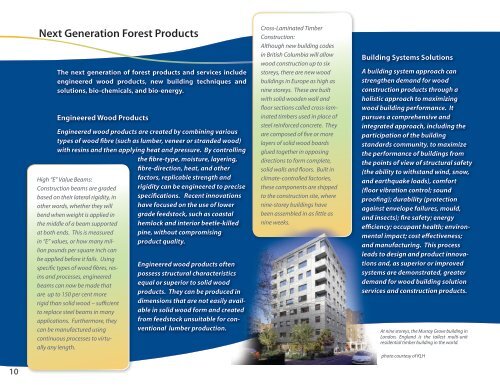Generating More Value from Our Forests - Ministry of Forests
Generating More Value from Our Forests - Ministry of Forests
Generating More Value from Our Forests - Ministry of Forests
You also want an ePaper? Increase the reach of your titles
YUMPU automatically turns print PDFs into web optimized ePapers that Google loves.
10<br />
Next Generation Forest Products<br />
The next generation <strong>of</strong> forest products and services include<br />
engineered wood products, new building techniques and<br />
solutions, bio-chemicals, and bio-energy.<br />
Engineered Wood Products<br />
Engineered wood products are created by combining various<br />
types <strong>of</strong> wood fibre (such as lumber, veneer or stranded wood)<br />
with resins and then applying heat and pressure. By controlling<br />
the fibre-type, moisture, layering,<br />
fibre-direction, heat, and other<br />
High “E” <strong>Value</strong> Beams:<br />
Construction beams are graded<br />
based on their lateral rigidity, in<br />
other words, whether they will<br />
bend when weight is applied in<br />
the middle <strong>of</strong> a beam supported<br />
at both ends. This is measured<br />
in “E” values, or how many million<br />
pounds per square inch can<br />
be applied before it fails. Using<br />
specific types <strong>of</strong> wood fibres, resins<br />
and processes, engineered<br />
beams can now be made that<br />
are up to 150 per cent more<br />
rigid than solid wood − sufficient<br />
to replace steel beams in many<br />
applications. Furthermore, they<br />
can be manufactured using<br />
continuous processes to virtually<br />
any length.<br />
factors, replicable strength and<br />
rigidity can be engineered to precise<br />
specifications. Recent innovations<br />
have focused on the use <strong>of</strong> lower<br />
grade feedstock, such as coastal<br />
hemlock and interior beetle-killed<br />
pine, without compromising<br />
product quality.<br />
Engineered wood products <strong>of</strong>ten<br />
possess structural characteristics<br />
equal or superior to solid wood<br />
products. They can be produced in<br />
dimensions that are not easily available<br />
in solid wood form and created<br />
<strong>from</strong> feedstock unsuitable for conventional<br />
lumber production.<br />
Cross-Laminated Timber<br />
Construction:<br />
Although new building codes<br />
in British Columbia will allow<br />
wood construction up to six<br />
storeys, there are new wood<br />
buildings in Europe as high as<br />
nine storeys. These are built<br />
with solid wooden wall and<br />
floor sections called cross-laminated<br />
timbers used in place <strong>of</strong><br />
steel reinforced concrete. They<br />
are composed <strong>of</strong> five or more<br />
layers <strong>of</strong> solid wood boards<br />
glued together in opposing<br />
directions to form complete,<br />
solid walls and floors. Built in<br />
climate-controlled factories,<br />
these components are shipped<br />
to the construction site, where<br />
nine -storey buildings have<br />
been assembled in as little as<br />
nine weeks.<br />
Building Systems Solutions<br />
A building system approach can<br />
strengthen demand for wood<br />
construction products through a<br />
holistic approach to maximizing<br />
wood building performance. It<br />
pursues a comprehensive and<br />
integrated approach, including the<br />
participation <strong>of</strong> the building<br />
standards community, to maximize<br />
the performance <strong>of</strong> buildings <strong>from</strong><br />
the points <strong>of</strong> view <strong>of</strong> structural safety<br />
(the ability to withstand wind, snow,<br />
and earthquake loads) ,<br />
comfort<br />
(floor vibration control; sound<br />
pro<strong>of</strong>ing); durability (protection<br />
against envelope failures, mould,<br />
and insects); fire safety; energy<br />
efficiency; occupant health; environmental<br />
impact; cost effectiveness;<br />
and manufacturing. This process<br />
leads to design and product innovations<br />
and, as superior or improved<br />
systems are demonstrated, greater<br />
demand for wood building solution<br />
services and construction products.<br />
At nine storeys, the Murray Grove building in<br />
London, England is the tallest multi-unit<br />
residential timber building in the world.<br />
photo courtesy <strong>of</strong> KLH

















